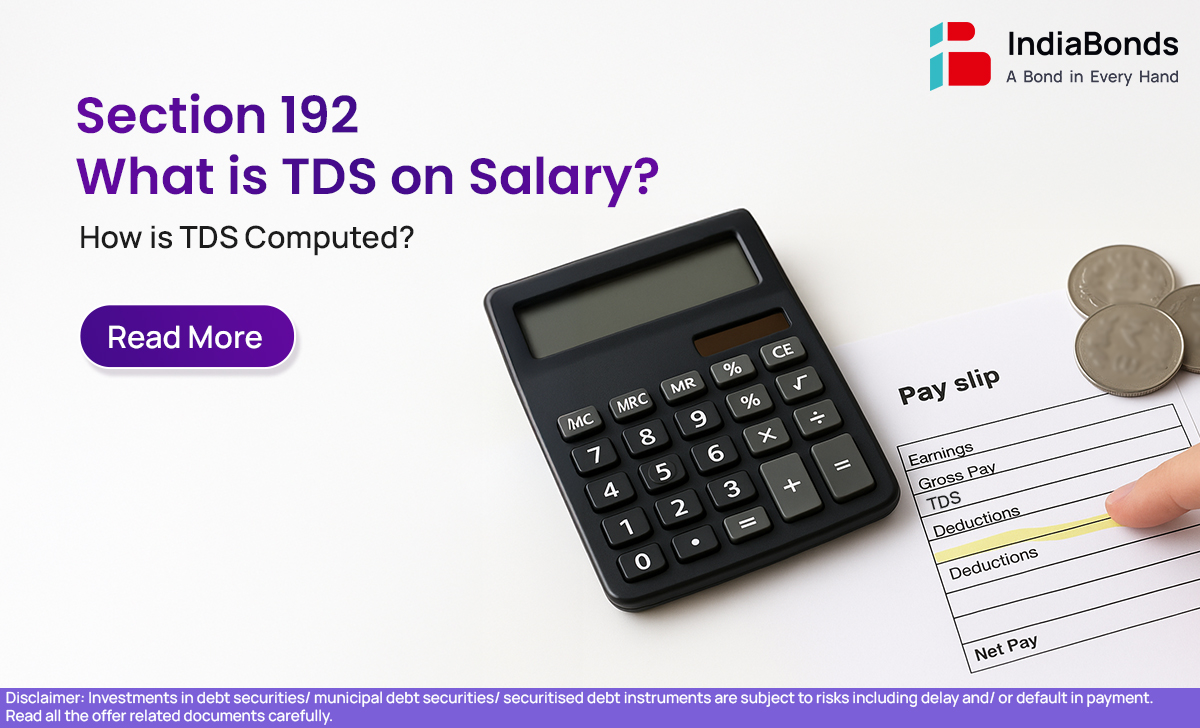Section 192 – What is TDS on Salary? and How is TDS Computed?

Introduction
Most salaried people see “TDS” on their payslip and wonder what exactly is happening. Think of it like advance income tax. The employer cuts a part of the salary every month and sends it to the government on the employee’s behalf. This is called TDS on salary under Section 192.
What Is TDS on Salary?
If someone asks, “what is TDS on salary?”—it is tax deducted by the employer from an employee’s taxable salary. The deduction is not at a flat rate. It is calculated on the basis of the income-tax slab rates for that year, after considering exemptions, deductions and any rebate the person is eligible for.
Who Can Deduct TDS Under Section 192?
Any employer who pays salary can deduct TDS—private companies, start-ups, partnership firms, LLPs, sole proprietors, HUFs, NGOs, even government offices. If there is an employer-employee relationship and a salary is paid, Section 192 applies.
When is TDS Deducted & Rate Of Deduction Under Section 192?
TDS is deducted at the time of each salary payment. The “rate” depends on the individual’s estimated annual taxable income and the chosen tax regime (old or new). Employers project the full-year income, apply slab rates, reduce eligible deductions/exemptions, and spread the tax across remaining months. The idea is to avoid a big tax shock in March.
How to Calculate TDS on Salary Under Section 192
A simple India-style example makes it clear:
| Step | What the employer checks (illustration) |
| 1 | Estimate annual gross salary (say ₹12,00,000 for Riya in Mumbai). |
| 2 | Subtract exempt parts of salary, if any (like HRA exemption if conditions fit). |
| 3 | Subtract standard deduction (currently ₹50,000 for salaried). |
| 4 | Consider investment proofs/claims under Chapter VI-A if allowed by the chosen regime (e.g., ₹1.5 lakh under 80C in old regime, health insurance under 80D, etc.). |
| 5 | Arrive at taxable income and compute tax as per slabs; add health & education cess. |
| 6 | Reduce reliefs (e.g., rebate u/s 87A if eligible) and TDS already deducted by a previous employer if disclosed. |
| 7 | Divide the remaining annual tax by months left in the year to get monthly TDS on salary. |
This step-by-step is what HR/payroll software follows in most Indian companies.
Salary from More than One Employer
If a person changes jobs mid-year, the new employer should know the earlier salary and TDS to avoid short- or over-deduction. The employee can share details through Form 12B. If not shared, the new employer will deduct TDS only on the new job’s salary, and the employee may have to pay extra tax (or claim refund) while filing the return.
TDS Statements
Employers file quarterly TDS statements in Form 24Q and the amounts appear in the employee’s Form 26AS/AIS on the income-tax portal. Employees should check these tds statements once in a while to ensure the tax deducted actually reflects against their PAN.
Time Limit to Deposit the Tax Under Section 192
After deducting TDS, employers must deposit it on time:
| Period of deduction | Due date to deposit |
| Deductions in March | 30 April of next financial year |
| Deductions in any other month | 7th of the following month |
Delays invite interest and other consequences.
TDS Return Filed by Employer
Employers submit Form 24Q quarterly: Q1 (Apr–Jun) due 31 July, Q2 due 31 October, Q3 due 31 January, and Q4 due 31 May. Correct and timely filing keeps an employee’s tds statements clean and avoids mismatch at return time.
TDS Certificate
Every employee should receive a TDS certificate called Form 16—generally by 15 June after year-end. Form 16 clearly shows total salary, exemptions, deductions, tax computation and total TDS deposited. Keep this tds certificate safely; it is the single most important proof for tax deducted on salary.
Consequences of Non-Compliance under Section 192
For employers: interest for late deduction/deposit, late-filing fee for returns, and penalties. For employees: if the employer misses deduction, the employee still has to pay the balance tax while filing the return, possibly with interest. In short, timely and correct compliance protects both sides.
Conclusion
Section 192 makes life simpler for salaried Indians by spreading tax across the year. The employer estimates total income, deducts TDS on salary monthly, files tds statements, and gives a tds certificate (Form 16). Employees should share proofs on time, disclose previous employment details, and review Form 26AS/AIS so that there are no surprises at filing time.
FAQ
Is TDS refundable on salary?
Yes, if the employer deducted more than the final tax liability, the extra shows up as refund when the income-tax return is filed. The refund is credited to the bank account after processing.
How is TDS on salary calculated?
The employer projects full-year income, subtracts eligible exemptions/deductions, applies slab rates for the chosen regime, adds cess, reduces any rebate, and divides the net tax by remaining months to arrive at monthly TDS.
How much TDS to deduct on salary?
There is no fixed percentage. It depends on the person’s estimated taxable income, investments and the regime selected. Two employees with the same CTC can have different TDS because their deductions/exemptions differ.
How to avoid TDS on salary?
One cannot “avoid” tax, but TDS can be reduced legally by submitting proofs on time—like rent details for HRA, investment declarations, health insurance premium receipts, home-loan interest (as applicable), and by choosing the most suitable tax regime. If the final tax is lower than TDS, the difference will be refunded after filing the return.
Disclaimer : Investments in debt securities/ municipal debt securities/ securitised debt instruments are subject to risks including delay and/ or default in payment. Read all the offer related documents carefully.
































